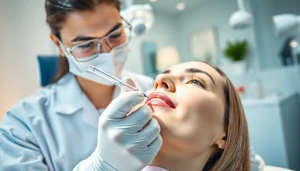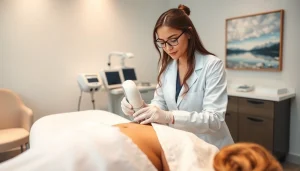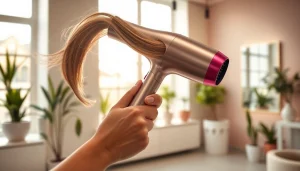Understanding Face Fillers: Benefits, Types, and What to Expect

What Are Face Fillers?
Definition and Purpose of Face Fillers
Face fillers, commonly known as dermal fillers, are injectable substances designed to restore facial volume, reduce wrinkles, and enhance overall facial contours. Primarily composed of hyaluronic acid, collagen, or other biocompatible materials, these fillers work by adding fullness to specific areas of the face, yielding immediate and noticeable effects. The primary purpose of face fillers is to address signs of aging, such as sagging skin and loss of volume, ultimately rejuvenating one’s appearance and providing a youthful glow.
With advancements in cosmetic procedures, face fillers have become increasingly popular among individuals seeking to enhance their facial features without the need for invasive surgery. They are favored by many because of their relatively quick application and minimal recovery time. For those interested in exploring options to redefine their facial aesthetics, face fillers offer a versatile solution with customizable results.
Different Types of Face Fillers
Face fillers can be categorized into several types based on their composition and intended use:
- Hyaluronic Acid Fillers: These are the most commonly used fillers, known for their ability to retain moisture, resulting in a plump and hydrated appearance. Brands such as Juvederm and Restylane fall within this category and are typically used for lip enhancement, cheek augmentation, and wrinkle reduction.
- Calcium Hydroxylapatite Fillers: These thicker fillers are often used in deeper facial wrinkles and provide a more volumizing effect. Radiesse is a well-known brand that belongs to this category. It stimulates collagen production and is commonly used for nasolabial folds and marionette lines.
- Poly-L-lactic Acid Fillers: Unlike other fillers, this one works gradually to replace lost collagen in the skin. Sculptra is a popular choice in this category, ideal for those looking for subtle results over time, typically used for enhancing volume in the cheeks and temples.
- Autologous Fat Injections: This method involves harvesting fat from one part of the body and injecting it into the facial area. While it requires surgical techniques, it provides longer-lasting results as it utilizes the body’s own fat.
- PMMA Fillers: Polymethyl Methacrylate is used as a semi-permanent filler, offering lasting results that can improve over time as it integrates into the tissue. Bellafill is an example of this type of filler, designed for treating nasolabial folds and acne scars.
Who Should Consider Face Fillers?
Face fillers are ideal for individuals experiencing volume loss due to aging, those wishing to enhance their facial features, or anyone looking to smooth out fine lines and wrinkles. Typically, candidates for face fillers:
- Are 21 years of age or older, and in good health.
- Have realistic expectations regarding the results, understanding that while fillers can enhance appearance, they do not achieve the results of surgical procedures.
- Seek a non-invasive option for facial rejuvenation with minimal downtime.
However, individuals who are pregnant, breastfeeding, or have certain health conditions, such as serious allergies or autoimmune disorders, should consult with their doctor before undergoing treatment.
Benefits of Using Face Fillers
Immediate and Long-Lasting Effects
One of the most appealing aspects of face fillers is their immediate effect. Within minutes of injection, individuals can begin to see visible changes that enhance their features. Many fillers provide results that can last anywhere from six months to two years, depending on the type of filler used and the area treated. This longevity means individuals can enjoy their refreshed appearance without needing frequent touch-ups.
Enhancing Facial Features
Face fillers are versatile and can be strategically applied to various areas of the face to enhance features. This includes enhancing the lips for a fuller look, smoothing out nasolabial folds, adding volume to cheeks, and contouring the jawline. The adaptability of fillers allows individuals to customize their treatment to meet their aesthetic goals, whether they desire subtle enhancements or more dramatic changes.
Boosting Self-Confidence
Many individuals report a significant boost in self-esteem and overall confidence post-treatment. The ability to address concerns about facial aging and volume loss can lead to a positive psychological impact, encouraging people to engage more in social situations and feel more satisfied with their appearance. The boost in self-confidence is often just as transformative as the physical changes brought about by the procedure.
Safety and Side Effects of Face Fillers
Common Risks Associated with Face Fillers
While face fillers are generally safe, some risks and side effects can occur, including:
- Bruising and Swelling: These are common reactions at the injection site, typically subsiding within a few days.
- Allergic Reactions: Though rare, some individuals may experience allergic reactions to the filler material utilized, emphasizing the importance of consulting with qualified practitioners.
- Infection: Similar to any injectable treatment, there’s a risk of infection if procedures are not conducted in sterile environments.
- Asymmetry: There is a possibility of uneven results, highlighting the need for skilled application.
Choosing a Qualified Practitioner
Selecting a qualified and experienced practitioner is crucial for minimizing risks associated with face fillers. Potential candidates should seek professionals certified in aesthetics, such as dermatologists or plastic surgeons, and ensure that they have a robust portfolio showcasing successful procedures. Before undergoing treatment, individuals should ask about their practitioner’s experience with fillers, the specific materials they use, and view before-and-after photos of past clients.
Aftercare Tips for Optimal Results
Post-treatment care is essential to ensure optimal results and minimize side effects. Recommendations typically include:
- Avoiding strenuous exercise for at least 24 hours post-treatment to reduce swelling.
- Refraining from touching or massaging the treated areas to prevent displacement of the filler.
- Applying ice packs to the injection sites can help with swelling and discomfort.
- Staying hydrated and maintaining a good skincare routine can enhance results and promote healing.
Face Fillers vs. Other Aesthetic Treatments
How Face Fillers Compare to Botox
While both face fillers and Botox are popular non-surgical cosmetic treatments, they serve different purposes. Botox is an injectable used primarily to temporarily paralyze muscles that cause dynamic wrinkles (like frown lines and crow’s feet), thus preventing the formation of fine lines during facial expressions. In contrast, face fillers work by adding volume and fullness to static lines and areas of volume loss, such as cheeks or lips. Understanding the distinct roles of these treatments is essential for individuals looking to achieve comprehensive facial rejuvenation.
Alternative Treatments for Volume Restoration
Besides face fillers, there are other options for those looking to restore facial volume:
- Fat Transfer: This involves liposuction to harvest fat from another area of the body, which is then injected into the face. It offers natural-looking results but requires more downtime.
- Thread Lifts: A minimally invasive procedure that uses threads to lift sagging skin, providing an immediate tightening effect but typically less volume restoration.
- Laser Treatments: Non-invasive options such as laser therapy can stimulate collagen production, gradually restoring volume and improving overall skin texture.
Choosing the Right Treatment for Your Needs
Making an informed decision about the right treatment depends on individual goals, desired outcomes, and concerns about recovery time. A thorough consultation with a licensed practitioner can significantly help in evaluating all options available. Those interested in targeting wrinkles might lean towards Botox, while individuals focusing on restoring lost volume may prioritize face fillers or fat transfer.
Real Results: Before and After Face Fillers
What to Expect During the Procedure
The procedure for receiving face fillers is relatively straightforward. It typically begins with an initial consultation where the aesthetic goals are discussed. The practitioner then marks the treatment areas, cleans the skin, and may apply a topical anesthetic to minimize discomfort. The filler is injected using a fine needle, and the process usually takes less than 30 minutes. Patients can witness instant results, which are often enhanced as swelling subsides over the following days.
Real-Life Success Stories
Many individuals have shared their success stories post-treatment, emphasizing how face fillers contributed positively to their appearance and self-esteem. For example, clients looking to reduce the deep folds around their mouths often report feeling more youthful and confident in social situations, which can profoundly affect their professional and personal life.
Furthermore, social media platforms are filled with testimonials and images demonstrating the transformation possible with face fillers, fostering a community where experiences, both positive and negative, are shared.
Factors Influencing the Results
The outcome of face fillers can be influenced by various factors, including:
- Type of Filler: Different fillers have varying characteristics, which can yield distinct results.
- Anatomy of the Patient: Individual facial structure and skin type play a crucial role in the overall effectiveness of treatment.
- Practitioner Skill: The experience and technique of the practitioner can significantly impact the final results.
- Post-Procedure Care: Proper aftercare can enhance results and prolong the longevity of fillers.







